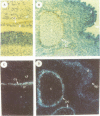Abstract
Proenkephalin A (PEA) encodes several neuropeptides with an opioid activity, as well as other peptides with as yet unknown functions. As an initial step toward finding possible roles for PEA gene products in non-neuronal tissues, we have determined sites of PEA expression during mouse embryonic development, employing in situ hybridization. We report here the unexpected observation that in addition to its abundance in brain, PEA RNA is expressed in non-differentiated mesodermal cells of diverse lineages in the process of their development into several adult tissues and organs; it drops to undetectable levels upon terminal differentiation of these tissues. In a particular example of differentiating mesoderm, the developing kidney, the transient expression of PEA mRNA and of its encoded peptide Met-enkephalin was demonstrated by both in situ and Northern blot hybridizations, as well as by a radioimmunoassay. These findings suggest a novel role for PEA-derived peptide(s) in mesoderm growth or differentiation during organogenesis.
Full text
PDF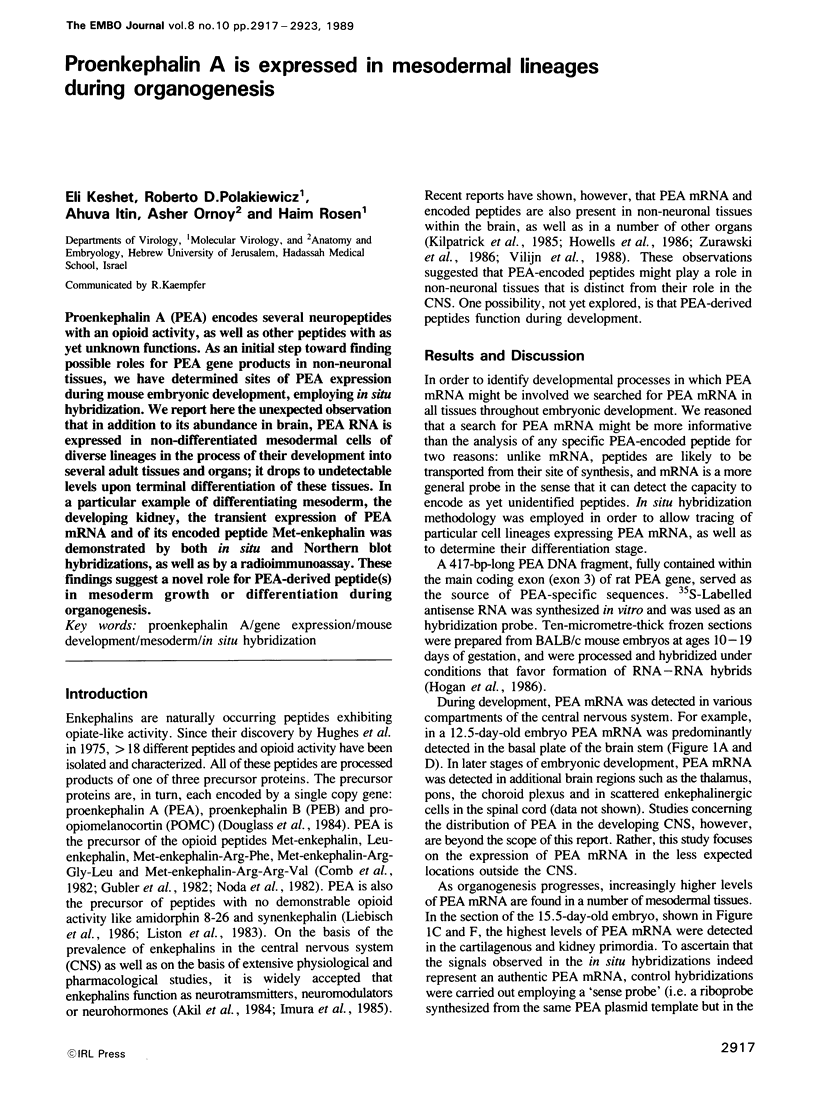
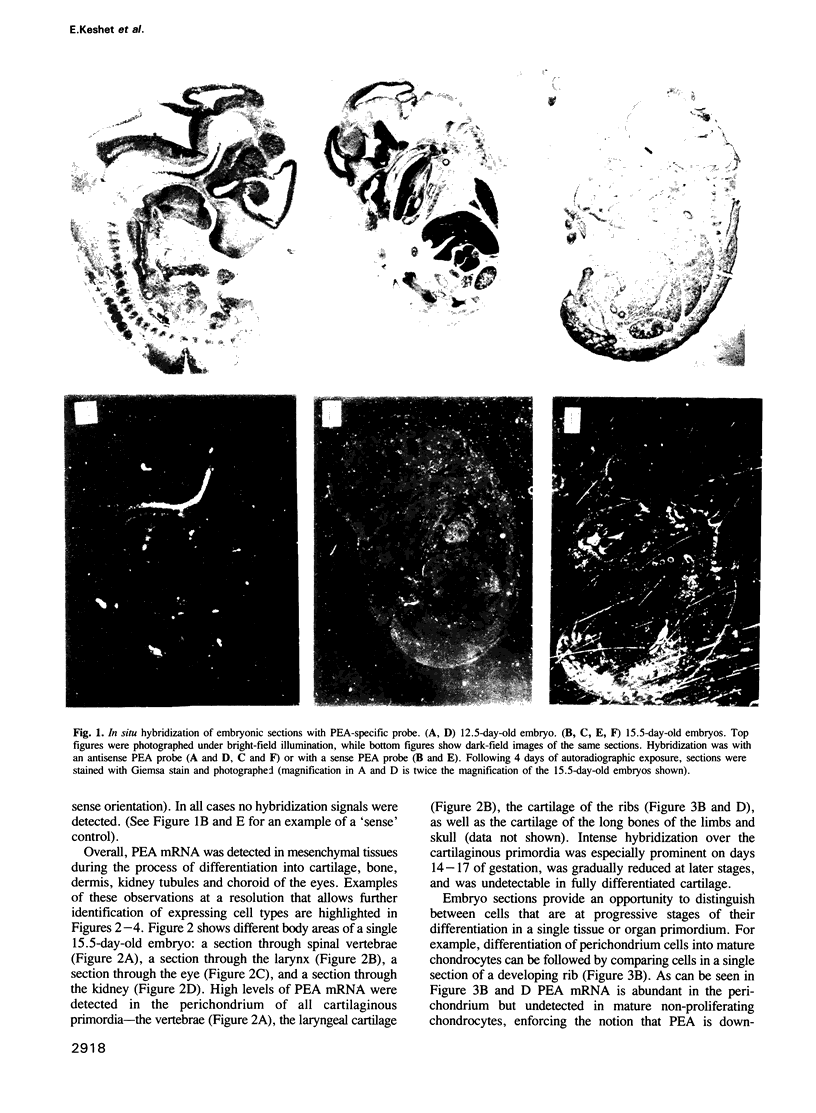
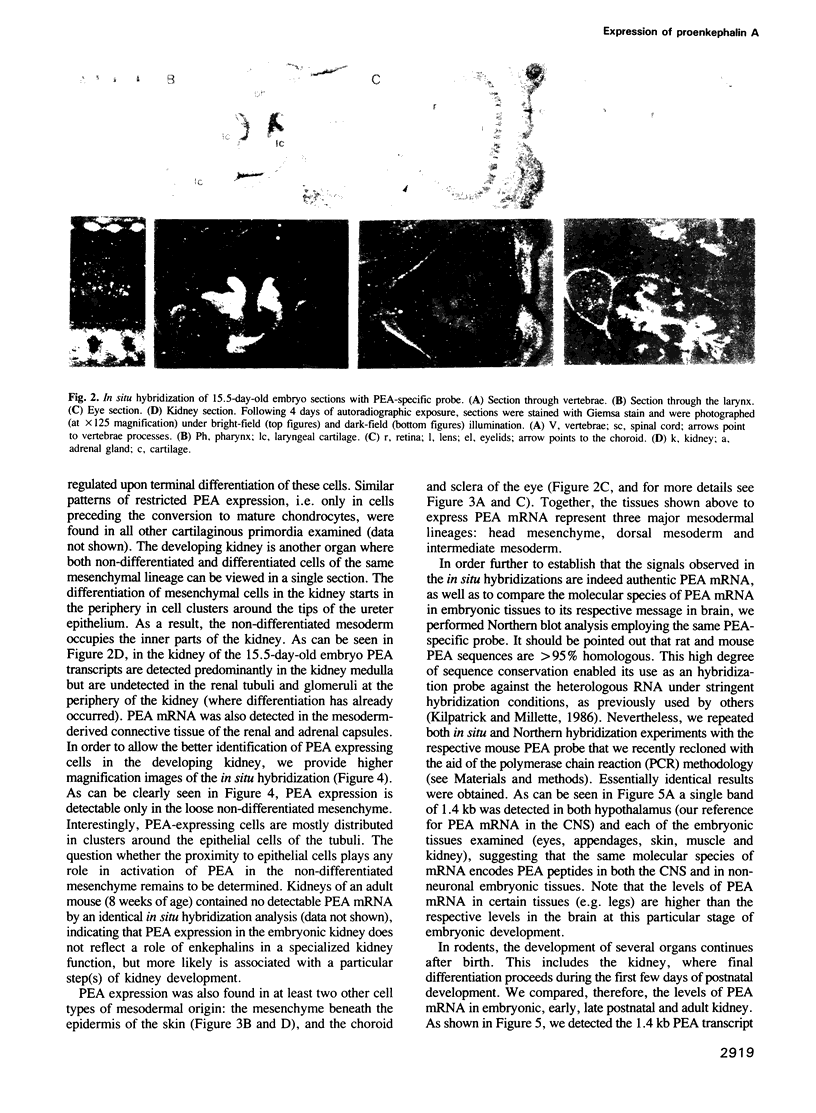
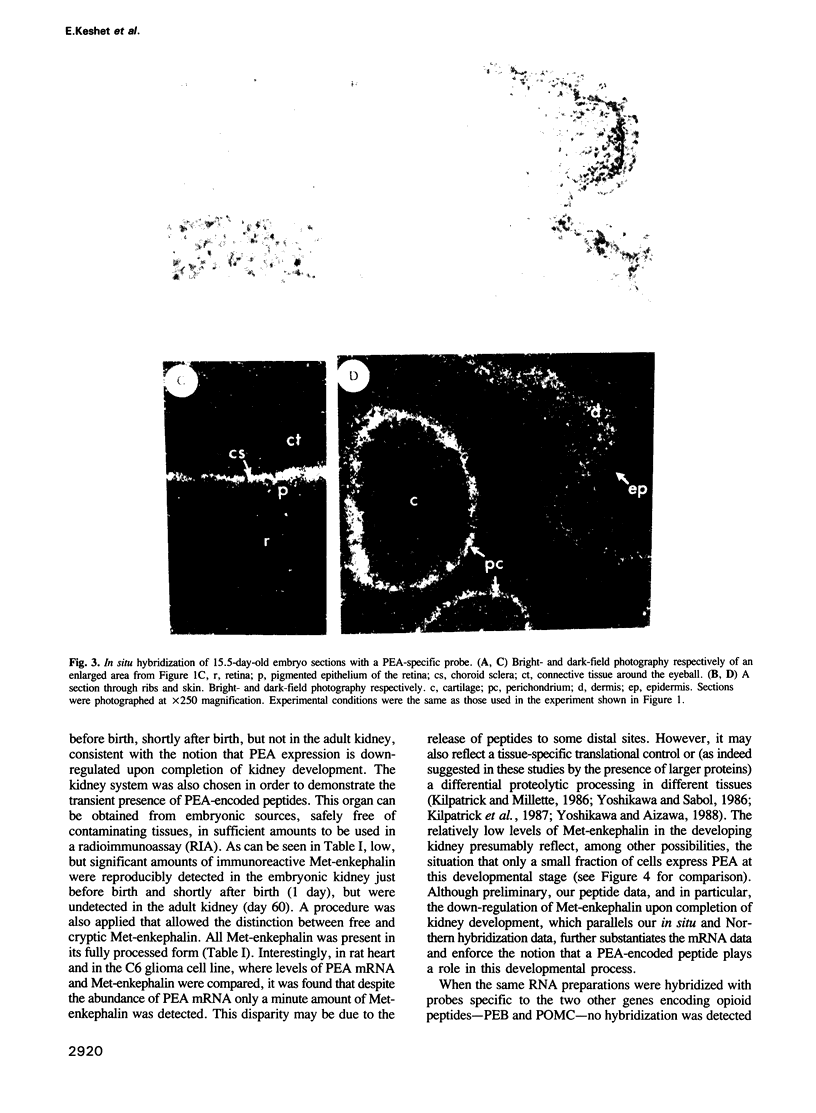
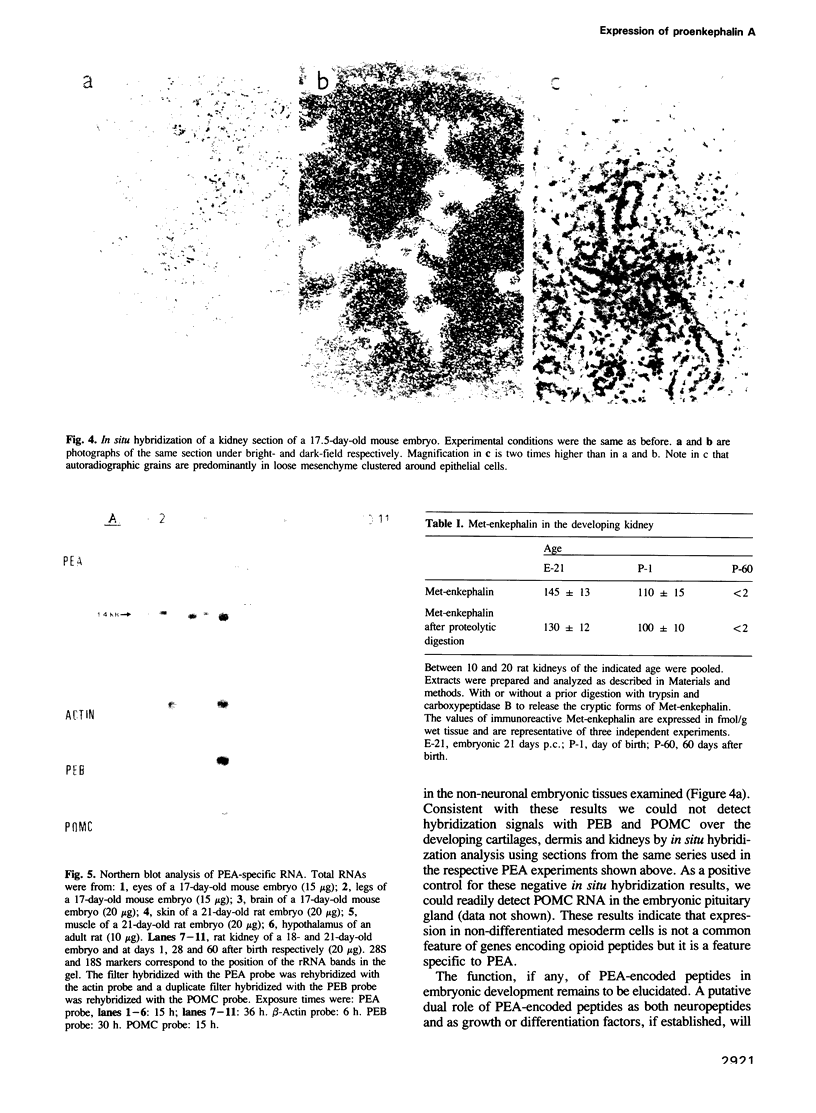
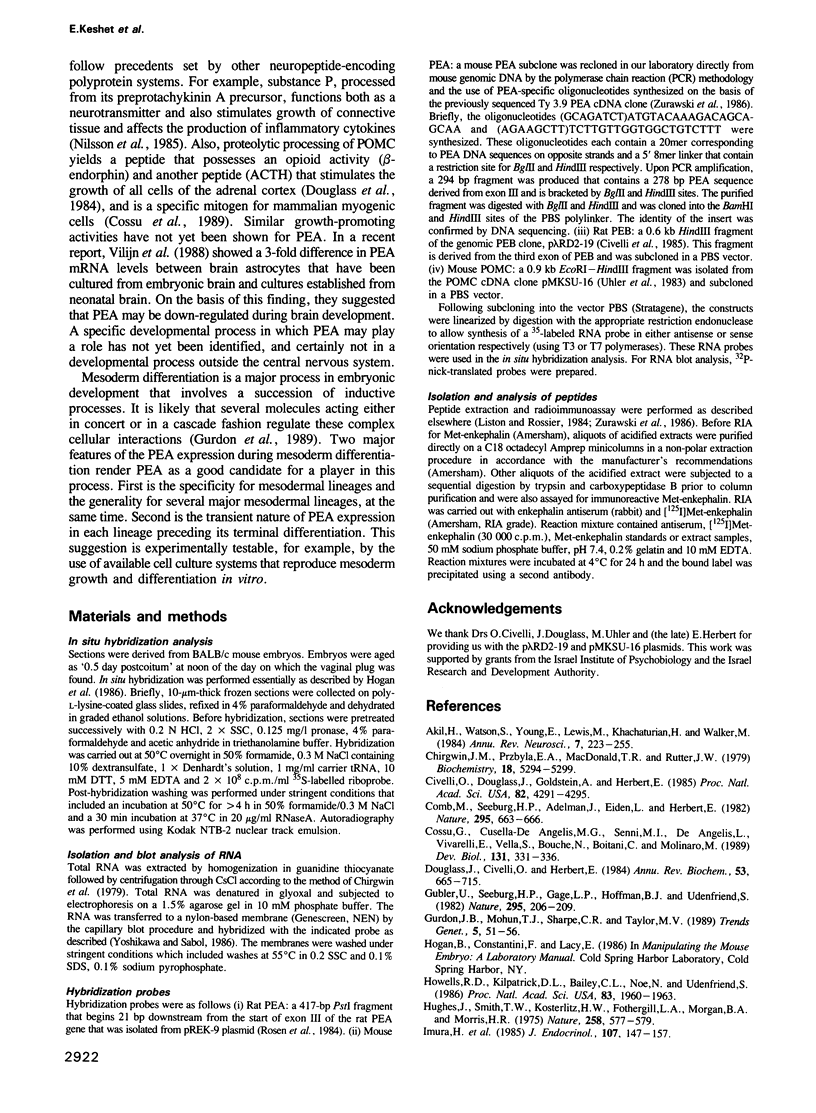
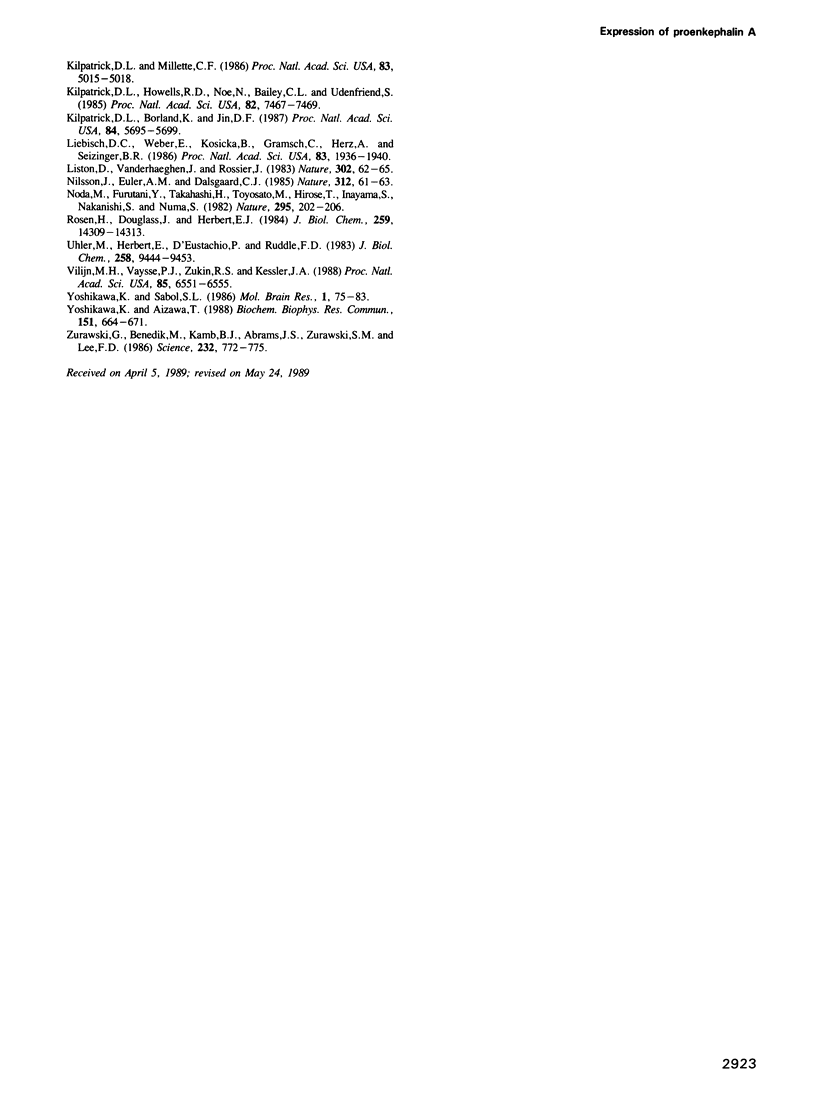
Images in this article
Selected References
These references are in PubMed. This may not be the complete list of references from this article.
- Akil H., Watson S. J., Young E., Lewis M. E., Khachaturian H., Walker J. M. Endogenous opioids: biology and function. Annu Rev Neurosci. 1984;7:223–255. doi: 10.1146/annurev.ne.07.030184.001255. [DOI] [PubMed] [Google Scholar]
- Chirgwin J. M., Przybyla A. E., MacDonald R. J., Rutter W. J. Isolation of biologically active ribonucleic acid from sources enriched in ribonuclease. Biochemistry. 1979 Nov 27;18(24):5294–5299. doi: 10.1021/bi00591a005. [DOI] [PubMed] [Google Scholar]
- Civelli O., Douglass J., Goldstein A., Herbert E. Sequence and expression of the rat prodynorphin gene. Proc Natl Acad Sci U S A. 1985 Jun;82(12):4291–4295. doi: 10.1073/pnas.82.12.4291. [DOI] [PMC free article] [PubMed] [Google Scholar]
- Comb M., Seeburg P. H., Adelman J., Eiden L., Herbert E. Primary structure of the human Met- and Leu-enkephalin precursor and its mRNA. Nature. 1982 Feb 25;295(5851):663–666. doi: 10.1038/295663a0. [DOI] [PubMed] [Google Scholar]
- Cossu G., Cusella-De Angelis M. G., Senni M. I., De Angelis L., Vivarelli E., Vella S., Bouchè M., Boitani C., Molinaro M. Adrenocorticotropin is a specific mitogen for mammalian myogenic cells. Dev Biol. 1989 Feb;131(2):331–336. doi: 10.1016/s0012-1606(89)80006-5. [DOI] [PubMed] [Google Scholar]
- Douglass J., Civelli O., Herbert E. Polyprotein gene expression: generation of diversity of neuroendocrine peptides. Annu Rev Biochem. 1984;53:665–715. doi: 10.1146/annurev.bi.53.070184.003313. [DOI] [PubMed] [Google Scholar]
- Gubler U., Seeburg P., Hoffman B. J., Gage L. P., Udenfriend S. Molecular cloning establishes proenkephalin as precursor of enkephalin-containing peptides. Nature. 1982 Jan 21;295(5846):206–208. doi: 10.1038/295206a0. [DOI] [PubMed] [Google Scholar]
- Gurdon J. B., Mohun T. J., Sharpe C. R., Taylor M. V. Embryonic induction and muscle gene activation. Trends Genet. 1989 Feb;5(2):51–56. doi: 10.1016/0168-9525(89)90022-x. [DOI] [PubMed] [Google Scholar]
- Howells R. D., Kilpatrick D. L., Bailey L. C., Noe M., Udenfriend S. Proenkephalin mRNA in rat heart. Proc Natl Acad Sci U S A. 1986 Mar;83(6):1960–1963. doi: 10.1073/pnas.83.6.1960. [DOI] [PMC free article] [PubMed] [Google Scholar]
- Hughes J., Smith T. W., Kosterlitz H. W., Fothergill L. A., Morgan B. A., Morris H. R. Identification of two related pentapeptides from the brain with potent opiate agonist activity. Nature. 1975 Dec 18;258(5536):577–580. doi: 10.1038/258577a0. [DOI] [PubMed] [Google Scholar]
- Imura H., Kato Y., Nakai Y., Nakao K., Tanaka I., Jingami H., Koh T., Yoshimasa T., Tsukada T., Suda M. Endogenous opioids and related peptides: from molecular biology to clinical medicine. The Sir Henry Dale lecture for 1985. J Endocrinol. 1985 Nov;107(2):147–157. doi: 10.1677/joe.0.1070147. [DOI] [PubMed] [Google Scholar]
- Kilpatrick D. L., Borland K., Jin D. F. Differential expression of opioid peptide genes by testicular germ cells and somatic cells. Proc Natl Acad Sci U S A. 1987 Aug;84(16):5695–5699. doi: 10.1073/pnas.84.16.5695. [DOI] [PMC free article] [PubMed] [Google Scholar]
- Kilpatrick D. L., Howells R. D., Noe M., Bailey L. C., Udenfriend S. Expression of preproenkephalin-like mRNA and its peptide products in mammalian testis and ovary. Proc Natl Acad Sci U S A. 1985 Nov;82(21):7467–7469. doi: 10.1073/pnas.82.21.7467. [DOI] [PMC free article] [PubMed] [Google Scholar]
- Kilpatrick D. L., Millette C. F. Expression of proenkephalin messenger RNA by mouse spermatogenic cells. Proc Natl Acad Sci U S A. 1986 Jul;83(14):5015–5018. doi: 10.1073/pnas.83.14.5015. [DOI] [PMC free article] [PubMed] [Google Scholar]
- Liebisch D. C., Weber E., Kosicka B., Gramsch C., Herz A., Seizinger B. R. Isolation and structure of a C-terminally amidated nonopioid peptide, amidorphin-(8-26), from bovine striatum: a major product of proenkephalin in brain but not in adrenal medulla. Proc Natl Acad Sci U S A. 1986 Mar;83(6):1936–1940. doi: 10.1073/pnas.83.6.1936. [DOI] [PMC free article] [PubMed] [Google Scholar]
- Liston D. R., Vanderhaeghen J. J., Rossier J. Presence in brain of synenkephalin, a proenkephalin-immunoreactive protein which does not contain enkephalin. Nature. 1983 Mar 3;302(5903):62–65. doi: 10.1038/302062a0. [DOI] [PubMed] [Google Scholar]
- Nilsson J., von Euler A. M., Dalsgaard C. J. Stimulation of connective tissue cell growth by substance P and substance K. Nature. 1985 May 2;315(6014):61–63. doi: 10.1038/315061a0. [DOI] [PubMed] [Google Scholar]
- Noda M., Furutani Y., Takahashi H., Toyosato M., Hirose T., Inayama S., Nakanishi S., Numa S. Cloning and sequence analysis of cDNA for bovine adrenal preproenkephalin. Nature. 1982 Jan 21;295(5846):202–206. doi: 10.1038/295202a0. [DOI] [PubMed] [Google Scholar]
- Rosen H., Douglass J., Herbert E. Isolation and characterization of the rat proenkephalin gene. J Biol Chem. 1984 Nov 25;259(22):14309–14313. [PubMed] [Google Scholar]
- Uhler M., Herbert E., D'Eustachio P., Ruddle F. D. The mouse genome contains two nonallelic pro-opiomelanocortin genes. J Biol Chem. 1983 Aug 10;258(15):9444–9453. [PubMed] [Google Scholar]
- Vilijn M. H., Vaysse P. J., Zukin R. S., Kessler J. A. Expression of preproenkephalin mRNA by cultured astrocytes and neurons. Proc Natl Acad Sci U S A. 1988 Sep;85(17):6551–6555. doi: 10.1073/pnas.85.17.6551. [DOI] [PMC free article] [PubMed] [Google Scholar]
- Yoshikawa K., Aizawa T. Enkephalin precursor gene expression in postmeiotic germ cells. Biochem Biophys Res Commun. 1988 Mar 15;151(2):664–671. doi: 10.1016/s0006-291x(88)80332-2. [DOI] [PubMed] [Google Scholar]
- Yoshikawa K., Sabol S. L. Expression of the enkephalin precursor gene in C6 rat glioma cells: regulation by beta-adrenergic agonists and glucocorticoids. Brain Res. 1986 Jul;387(1):75–83. doi: 10.1016/0169-328x(86)90022-7. [DOI] [PubMed] [Google Scholar]
- Zurawski G., Benedik M., Kamb B. J., Abrams J. S., Zurawski S. M., Lee F. D. Activation of mouse T-helper cells induces abundant preproenkephalin mRNA synthesis. Science. 1986 May 9;232(4751):772–775. doi: 10.1126/science.2938259. [DOI] [PubMed] [Google Scholar]





